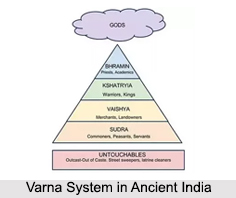 Varna System in Ancient India was based on occupation, but with time it turned to a rigid caste system. ‘Varna’ literally means group in Sanskrit. With the advent of the Aryans, the ancient Indian society got divided into four sections - Brahmin, Kshatriya, Vaishya and Sudra. In Hinduism, the Varna System was based on class, colour, guna and yoga.
Varna System in Ancient India was based on occupation, but with time it turned to a rigid caste system. ‘Varna’ literally means group in Sanskrit. With the advent of the Aryans, the ancient Indian society got divided into four sections - Brahmin, Kshatriya, Vaishya and Sudra. In Hinduism, the Varna System was based on class, colour, guna and yoga.The first 3 Varna is called twice born. It implies that they have come of age and are eligible to study Sanskrit and the Vedas and perform Vedic rituals. The thread ceremony marks the second birth among the Indian male. For girls it is during their marriage that a thread is tied round their hands to mark the second birth. Besides Hindus, this custom is also prevalent with the Jains.
Historical Evidences of Varna System
The reference to the Varna System can be traced back to the religious textsof the land. In Mahabharata (Anushasana Parva, Chapter 163) it is said: "O Devi, if even a Sudra is actually engaged in the occupation and pure behaviour of a Brahmana, he becomes a Brahmana. Moreover, a Vaishya can become a Kshatriya. Therefore, neither the source of one’s birth, nor his reformation, nor his education is the criterion of a Brahmana. The vritti, or occupation, is the real standard by which one is known as a Brahmana". So it is not birth but one’s karma that decided his class.
According to Rig Veda, the creator of the 4 groups is Lord Brahma. Each Varna sprang from the different body parts of the Lord. Brahmins originate from His mouth and they looked after the spiritual needs of the society. They were, thus, the learned men who could guide those who ruled the society. The Kshatriyas evolved from the arms and were the warrior class or the ruling class. The Vaishyas originated from the thighs and are comprised of the merchants, artisans and craftsmen. The Sudras developed from His feet and they formed the base of the ancient Indian society. Peasants, cobblers, servants and others came from this section of the community. The Varna system was, thus, merely based on occupations.
For more, visit the link below: